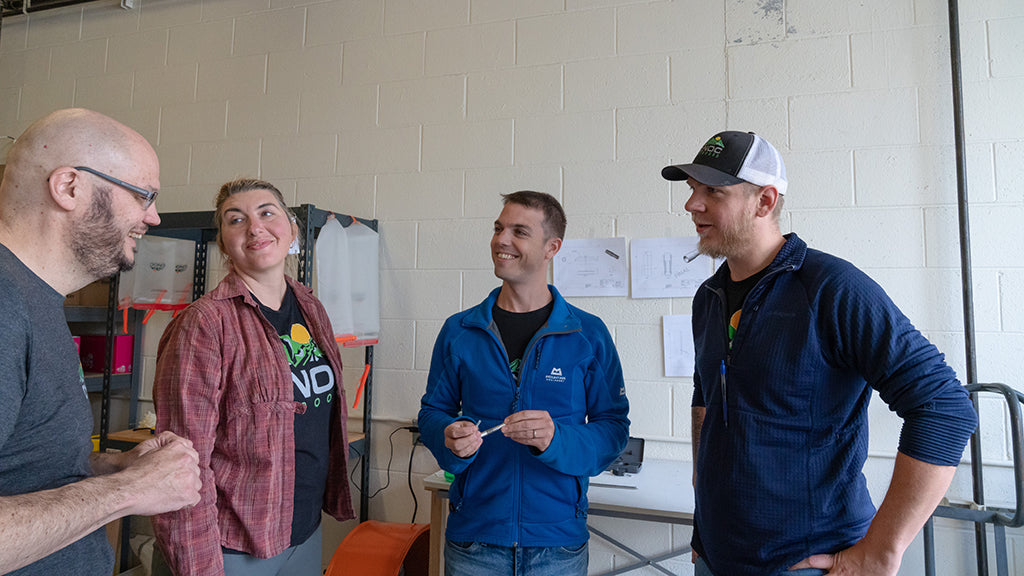From Vertex to Kickstarter

Poles are now available for purchase!
When I started Cnoc Outdoors in 2016, my plan was to make the best carbon poles on the market. We began by making the Vertex poles, in the same way as everyone else—sourcing from China, where the infrastructure and supply chains are already firmly established. But because we were (and still are) such a small company, we couldn’t monitor quality assurance in the factory and had constant issues with the poles. In the summer of 2017, we got another batch that had a number of QA issues: breaking around the button, bonding issues, etc. We had a bunch of ideas on how to improve the poles by making some small adjustments, but the factory wasn’t really interested in pursuing these modifications. We realized that if we wanted to be able to truly make the best poles, with proprietary innovations, we had to make them close to home.
The search for the right factories and the right parts
We began searching for a different way to make better carbon fiber poles, by doing it in the United States. We reached out to dozens of factories. It might even be close to a hundred by now. These were factories making all of the different components that go into a pole. Some companies preferred to stick to their small batch orders, rather than join our ambitious endeavor. Other factories were charging five times more per part, compared to what we had paid previously. Several factories never responded, or what they had to offer wasn’t an exact match to what we needed. Even after we found a few possible collaborators, some components didn’t reach our standards during testing.
Carbon Fiber

Our initial carbon fiber manufacturer in Michigan realized they didn’t have production capacity for our needs. Finding a new factory that we could work with—that could offer us the right tubes at the right price—was very hard and frustrating. It felt like going back to the drawing board in many ways, and forced us to change the final price point of the poles dramatically. In the end, Goodwinds Composites won our trust when we tested the strength of their poles against competitors.
Friction Quick Lock
Making the Friction Quick Lock (FQL) was a real challenge. The molds that we had originally made were for a Michigan factory working with our original carbon fiber manufacturer. Once that relationship ended, factories closer to home (in the Pacific Northwest) didn’t have the tools nor capacity to work with them. New molds would cost around $100-150K. Smaller companies that could work with our molds were mostly too small, but Rex Plastics was right in the middle. They work with small batches but have big manufacturing capacity.
Then our molds got stuck in Michigan, parts got lost along the way, and we needed to spend thousands more dollars to make the molds operable, delaying the poles again and again.
Grips

For the grips and straps, we spoke to so many companies we’ve lost track in order to find domestic cork and EVA. But our search was hopeless. Cork isn’t grown in the US. EVA is not produced in the US. So, we had to seek solutions in south east Asia. We tested samples from three factories there, with one being a clear winner in results and quality.
Why Bother?
We felt like quitting many times–every time that a big part of the process collapsed, or we were billed another tens of thousands of dollars to make a small part. It was a seemingly-endless road of hurdles and conversations about how much longer we could continue.
The main reason we didn’t give up on the poles is probably sheer stubbornness and a reluctance to quit. Another reason is simple business acumen: if it is so hard for us, it is hard for everyone, so if we succeed, we will probably be the only ones that do this. Not relying on mediocre, off the shelf parts means that our poles are as unique and efficient as we want them to be. That, by itself, is a reason to get them to market.
Our Aha Moment

We finally had an aha moment when we accepted that we would be moving from a company that pays factories to make our things (white labeling) to a company that manufactures. Over time, more and more of the supply chain moved into our hands: finding factories to make components rather than the poles as a finished product. Understanding that we needed to source the granular parts and then would be assembling them in-house was the final aha in the process: We make trekking poles!
Building a Kickstarter Campaign
We never asked anyone for money to fund the whole project, only portions of it. We got rejected by at least four banks when looking for loans to fund the tooling and machinery for the poles. Instead, we used a different tactic and got a line of credit (SBA backed) for buying Vectos (our dual-opening collapsable water containers), to free up company money for the poles.
So far we have managed to fund almost all the tooling needed from selling Vectos. We have a few last things that require roughly $55k. The big problem is MOQs (Minimum Order Quantities).
Most factories won’t make a new part without a high MOQ (or high price cost), so we needed to look for people to help us buy the parts—hence the crowdfunding campaign. Crowdsourcing the last part of the funding of the project is the only way we can think of that to sustain the business. The Kickstarter ties the purchase of parts to the interests of our customers.
Thank you all for your continued support of our small but mighty outdoor company. Please join in backing our Kickstarter to help us bring these made-in-the-USA carbon fiber poles to you.









Really love what you guys are doing. Found you because of the Vectos bags and LOVE them! If I had need for trekking poles I’d buy from you guys :) . Best of luck!
Leave a comment